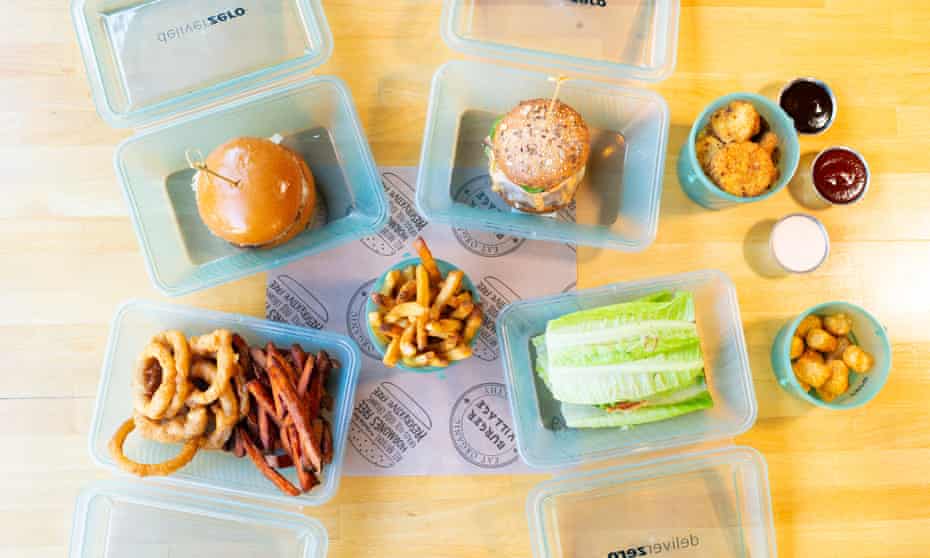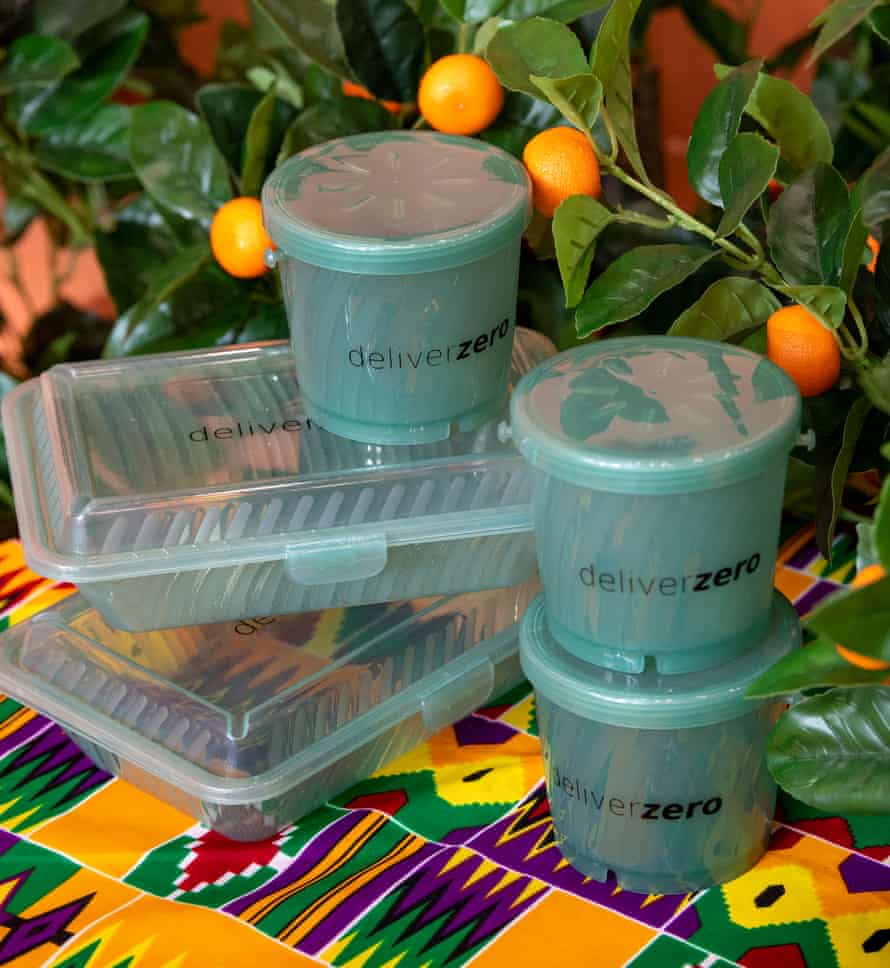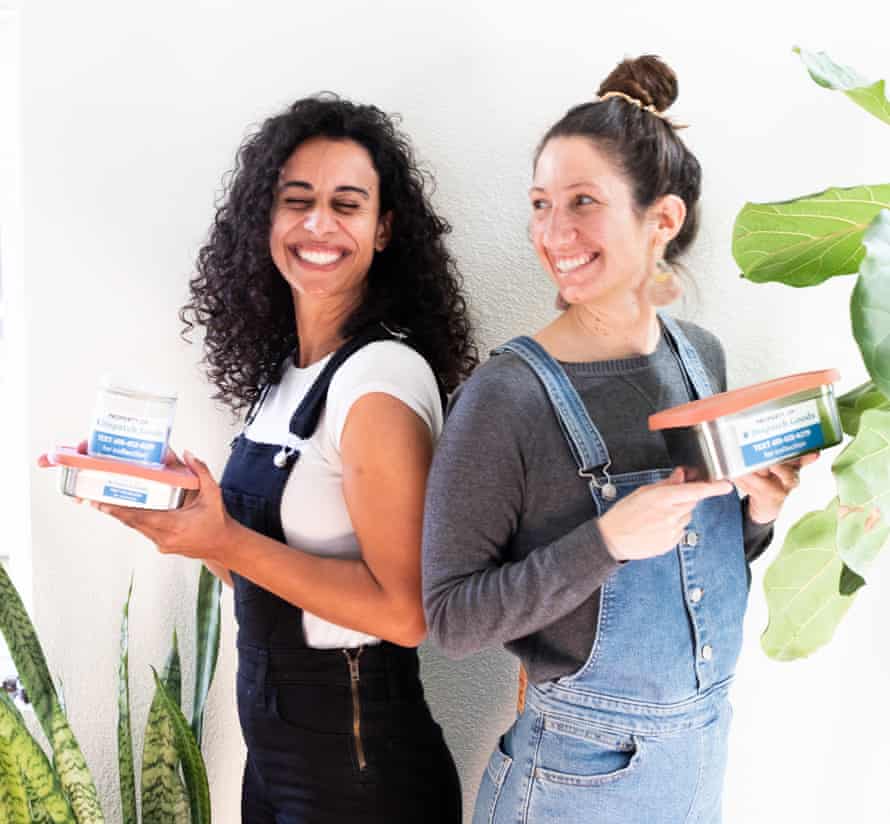‘The cusp of a reuse revolution’: startups take the waste out of takeout
More than 70% of Americans report ordering takeout or delivery one to three times a week – resulting in hundreds of billions of single-use products

Last modified on Fri 22 Oct 2021 09.23 EDT
The first question Lauren Sweeney set out to answer when she co-founded DeliverZero, a platform for ordering meals in reusable containers, was: do other people care about takeout packaging waste? “Is it just me standing in front of recycling bins with sushi containers knowing they’re not going to be recycled?” she asked herself at the time.
It wasn’t just her. In November 2019, she and two partners launched the DeliverZero website, where people could place takeout orders that would arrive in reusable boxes instead of the standard disposables. Despite offering food from only a few restaurants in one Brooklyn neighborhood and having a “very bad” user interface the app quickly took off.
Sweeney, who is the chief marketing officer, and her co-founders, Adam Farbiarz and Byron Sorrells, spent three months expanding in Brooklyn and were just about to cross into Manhattan when Covid struck. They shut down, redesigned and relaunched in the summer of 2020, when New Yorkers were hunkered down at home, hankering for meals cooked by someone else.
Now, more than 130 restaurants in two boroughs dispatch their food in sturdy green polypropylene containers furnished by DeliverZero, which can be returned, washed and reused 1,000 times apiece.
More than 70% of Americans report ordering takeout or delivery one to three times a week, according to a survey by the Ocean Conservancy, and demand for food delivery increased by about 15% during the pandemic. The result is hundreds of billions of single-use products – plastic boxes that often don’t or can’t get recycled, fiber bowls that leach harmful chemicals into the environment, compostable cups breaking down in landfills and releasing methane, a powerful greenhouse gas.
DeliverZero is one of a growing number of startups trying to take the waste out of takeout. Success hinges on solutions that scale and an increasing consumer appetite for sustainability.
“What we really want to do is displace single-use packaging [and] replace it with a network of reusable containers that are easy to receive and easy to return,” Sweeney said. Over their lifetimes, reusable containers create lower greenhouse gas emissions and use less energy and water than single-use containers, even after dishwashing.
“There are a number of innovative startups proving that takeout doesn’t need to be synonymous with large volumes of disposable waste,” said Olga Kachook, a senior manager at the Sustainable Packaging Coalition.
Their progress can be seen in Denver; Seattle; San Diego; Portland, Oregon; Minneapolis-Saint Paul; Durham, North Carolina; and on the Hawaii island of O?ahu. Even big global brands are testing the waters. Burger King will pilot reusable soda cups and Whopper boxes in New York City and Portland, Oregon, by early 2022. McDonald’s started serving coffee in reusable cups in some UK locations this summer.
“We are on the cusp of a reuse revolution,” according to a statement by Bridget Croke, managing director of Closed Loop Partners, an investment firm that funds circular economy projects, in a recent report. Emerging models, she predicted, will “build reuse back into our cultural and behavioral norms”.
Ordering food in reusable containers is fundamentally the same as doing it the “old-fashioned” way, with an extra step or two at the start and end. The details vary slightly between companies, and many are designed for in-person pickup.
The startups provide restaurants with containers, usually made from durable, recyclable plastic, which leak less than disposables and retain heat better. Often they are stamped with a QR code and checked out, like a library book, to customers who flash an app on their phone when picking up their food. Some companies require customers to pay a few dollars a month for a subscription, others charge a small fee per box and a few are free.
Customers return the rinsed containers to participating restaurants or at drop-boxes. They’re charged penalties or lose their deposit if they don’t. Return rates tend to be high.

DeliverZero, which was designed for ordering from and delivering to customers’ homes, makes returns especially easy. Customers can drop off boxes at any DeliverZero restaurant, or hand them to the courier who brings the next meal to their door.
In most arrangements, restaurants pay for reusable boxes at rates competitive with the cost of disposables. They might pass some cost on to the customer in the form of fees or in the price of food.
DeliverZero does not charge restaurants or customers for the boxes themselves. Instead, the company takes a commission that tends to be between 5% and 20% of sales. “We haven’t taken higher than 22.5%, which is the floor for other platforms,” Sweeney said. Companies such as Seamless and its parent, GrubHub, drew ire for charging restaurants upward of 30% an order during the worst of the pandemic, leading cities including New York and San Francisco to cap delivery fees.
DeliverZero is in the process of making its reusable boxes available on other big platforms, for 25 cents a box. Sweeney wants to make it possible for diners to get their food in reusable containers, even if they prefer to stick with the delivery apps already on their phones.
As much as 80% of a restaurant’s outgoing orders are for delivery, according to Maia Tekle, who worked at delivery company Caviar before co-founding Dispatch Goods in San Francisco. “You just can’t tackle the [packaging] problem unless you tackle delivery,” said co-founder and chief executive officer Lindsey Hoell. Most of the delivery orders from the 50 or so restaurants that use Dispatch Good’s stainless steel dishes come through third-party apps.

Hoell and Tekle aim to make reuse as routine as recycling. They envision a “fourth bin” for reusables, next to trash, recycling and food scraps.
Dispatch Goods runs weekly pickup routes, much like curbside waste collection. Users schedule home pickup, and drivers retrieve tins along with reusable items from other companies such as mason jars and meal kit freezer packs, which the company sells to grocery stores and other businesses that want to use upcycled packaging.
Regulation and public partnerships could help build a more robust reuse system, said Sarah Currie-Halpern, co-founder of waste reduction consultancy Think Zero. “I don’t think that the private sector can bring reusables mainstream on its own.”
A small tax on disposables could fund new return kiosks and dishwashing facilities, she said, and local governments could support fledgling companies. The city of Boulder, for example, partnered with RepEATer on its reusable takeout container program, offering grant funding and helping it attract new restaurants and diners. Several cities and states are moving to restrict or ban single-use plastics in restaurants. In Germany, restaurants that offer takeout will be required to offer reusable containers starting in 2023.
Hoell is confident her reuse model can work outside the dense, eco-conscious enclaves of northern California, noting that delivery services like DoorDash and Instacart are flourishing in the suburbs and the zero-waste movement has lots of momentum.
“It may be a while before we are in rural Arkansas, but all metro areas with populations over 500,000 are opportunities for the fourth bin system,” she said.
Sweeney, too, is optimistic. She said that New York, where some residents have never turned on their ovens, is uniquely positioned. “But across the world people are eating food they didn’t make themselves,” she said. “There’s a market for sustainable reusable systems everywhere.”
